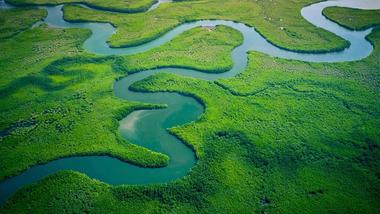
Protecting biodiversity and regenerating nature
Average read time: 5 minutes
We’re acting now to regenerate our ecosystems and prevent further biodiversity loss.
Understanding what’s at stake
Many of the raw materials we use in our products come from natural ecosystems – mainly agricultural land and forests. Nature also provides ecosystem services – many of which are 'free'. Waste decomposition, flood control, pollination of crops, water purification, carbon sequestration, climate regulation – globally, these and other services are worth at least US$125 trillion per year.
With that dependency comes a risk that the biodiversity, which sustains these ecosystems, is impacted by climate change or unsustainable farming and forestry practices. This in turn could impact the supply of vital raw materials that we need to make our products, and the resilience of our supply chain.
The combined effects of climate change, nature degradation, water scarcity, unsustainable farming and forestry – as well as other externalities – have led to a biodiversity crisis. Right now, a million species are at risk of extinction – and unless we all take action, ecosystem collapse threatens to destroy irreplaceable animals and plants. However, these are not just environmental issues; they also have a devastating impact on people’s lives and livelihoods. The UN Food and Agriculture Organization reports that biodiversity loss threatens the security of the world’s food supplies and the livelihoods of millions.
But through the blueprint laid down by the UN Sustainable Development Goals, we know what we need to do. And while time is not on our side, we have a window to act and there is a way forward. The scale of action that's needed to restore nature is huge – but so is the motivation, especially for businesses.
With the planet in crisis, we must do our part to restore its health. That’s why we have set out a range of ambitious actions to fight climate change and protect nature as part of our Unilever Compass.

What are we doing to protect biodiversity and regenerate nature?
By increasing the scale of the action we’re taking within our own business and in partnership with others, we can help to regenerate nature and build systems that protect biodiversity. We’re now building on the actions taken through the Unilever Sustainable Living Plan (USLP), using the reach and scale of our business and supply chain to create more change through the Unilever Compass.
We have committed to a deforestation-free supply chain by 2023. This means that by the end of 2023 our palm oil, paper and board, tea, soy and cocoa will come from places that are verified as deforestation and conversion free, by which we mean that natural ecosystems haven’t been converted to farmland. We believe that, to make the greatest impact, we must focus on generating change at our raw materials’ origin. That’s why we are concentrating on the critical first mile – from where our commodities are sourced, to where they are first processed.
Together, our Beauty & Wellbeing and Personal Care business groups have committed to protect and regenerate 1.5 million hectares of land, forests and oceans by 2030, which is more land than we need to grow the renewable ingredients that are in our beauty and personal care products. Our brands can also draw from our new €1bn Climate and Nature Fund so they can take meaningful action on landscape restoration, reforestation, carbon sequestration, wildlife protection and water preservation – and some of our brands already have plans in the pipeline.
Protecting biodiversity is central to our Sustainable Agriculture Programme, which was inspired by our ambition to buy agricultural raw materials from farms applying sustainable agricultural practices in the USLP. Through developing tools such as our Sustainable Agriculture Code and most recently our People & Nature Policy and our Regenerative Agriculture Principles, one of the key ways in which we’re tackling biodiversity loss is by working with our suppliers.
Seizing the opportunity to act quickly – and collectively
Research shows that if the world conserves 30% of land in strategic locations, we could keep around half of the world’s vulnerable terrestrial carbon stocks in the ground and reduce the extinction risk of nearly nine out of ten threatened species.
Developing nature-based climate solutions means collective action and advocacy. So, we’re working with Business for Nature, One Planet Business for Biodiversity (OP2B), the World Business Council for Sustainable Development, the World Economic Forum, the Science Based Targets Network and WWF amongst others to collectively drive action. That's why we're supporting Business for Nature's call to action: Nature is Everyone's Business. It has brought together more than 900 companies with revenues of US$4.3 trillion to call on governments to adopt policies now to reverse nature loss in this decade.
High ambitions, and global agreement
We need ambitious global agreement and action on nature if we’re to build a stable net-zero, nature-positive and equitable future in which humanity and all life on earth can thrive.
There are encouraging signs. In 2020, the High Ambition Coalition for Nature and People was launched. Supported by more than 50 countries, it commits to protecting at least 30% of the world’s land and ocean by 2030. Similarly, the Leaders’ Pledge for Nature, signed by 84 heads of state and the EU President, commits signatories to reverse biodiversity loss by 2030.
We call on all governments to endorse the Leaders Pledge for Nature and join the High Ambition Coalition, and to adopt a transformative Global Biodiversity Framework at the Conference of the Parties (COP15) to the Convention of Biological Diversity (CBD).
At the same time, we believe businesses must take steps now to regenerate nature, assess their impacts, and commit to ambitious goals and achieving science-based targets.